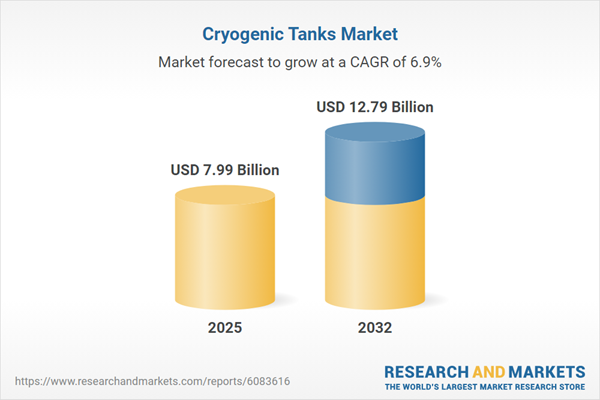Speak directly to the analyst to clarify any post sales queries you may have.
The cryogenic tanks market is rapidly advancing as global industries pursue next-generation solutions for safe, efficient storage and transport of liquefied gases. Strategic investments, regulatory evolution, and technology integration are supporting resilient growth, with stakeholders demanding robust performance, compliance, and sustainability across key sectors.
Market Snapshot: Cryogenic Tanks Market Size and Growth Trajectory
The cryogenic tanks market grew from USD 7.47 billion in 2024 to USD 7.99 billion in 2025. With a compound annual growth rate (CAGR) of 6.94%, the market is expected to reach USD 12.79 billion by 2032. Demand is driven by the adoption of cryogenic technologies in energy, healthcare, and advanced manufacturing, together with infrastructural expansions and evolving sectoral needs.
Scope & Segmentation: Technologies, Applications, and Regional Coverage
- Liquid Types: Argon, Helium, Hydrogen, LNG, Nitrogen, Oxygen
- Storage Capacities: Large systems for centralized and marine use, medium units for regional distribution, small vessels for laboratories and healthcare
- Material Types: Aluminum for lightweight corrosion resistance, Steel for high-pressure environments, Composite Materials maximizing efficiency and insulation
- Applications: Storage installations, Transportation solutions
- End-Use Sectors: Aerospace & Defense, Electronics, Energy (transitional and established projects), Food & Beverage, Healthcare
- Regions Covered:
• Americas (including the United States, Canada, Mexico, Brazil, Argentina, Chile, Colombia, Peru)
• Europe, Middle East, Africa (United Kingdom, Germany, France, Russia, Italy, Spain, Netherlands, Sweden, Poland, Switzerland, United Arab Emirates, Saudi Arabia, Qatar, Turkey, Israel, South Africa, Nigeria, Egypt, Kenya)
• Asia-Pacific (China, India, Japan, Australia, South Korea, Indonesia, Thailand, Malaysia, Singapore, Taiwan) - Key Companies: Air Liquide, Air Products and Chemicals, Air Water, Airbus, Chart Industries, Linde, Messer Group, Thermo Fisher Scientific, VWR International, as well as other regional and specialized manufacturers
Key Takeaways for Decision-Makers
- Technological innovation in insulation and materials has led to greater operational efficiency and extended asset lifespans, essential for industries handling sensitive or hazardous liquefied gases.
- Recent regulatory changes and environmental policies are prompting a shift toward sustainable design and manufacturing, especially for sectors focused on energy transition and cleaner fuel technologies.
- The increasing role of digital monitoring, embedded sensors, and predictive analytics is transforming maintenance protocols from reactive to proactive, helping reduce downtime and improve safety.
- Hydrogen’s emergence as a green energy vector and ongoing LNG infrastructure projects are redefining supply chain requirements and stimulating tailored engineering across global markets.
- Strategic collaborations, from research partnerships to joint ventures, are supporting geographic expansion and portfolio diversification, allowing providers to address rapidly changing regional and sectoral demands.
Tariff Impact: Navigating US Policy Influences
Shifts in United States tariff policies on specialized alloys and insulation components are prompting manufacturers to enhance domestic capabilities and reconsider global procurement strategies. These developments are accelerating investments in local production and driving exploration of alternative materials, while supply chains adapt through integrated agreements for greater transparency and resilience. Realignment of logistics and supplier relationships is helping stakeholders manage price volatility and ensure ongoing competitiveness.
Methodology & Data Sources
This report uses a rigorous blend of qualitative interviews with industry experts and quantitative analysis of sector data. Insights are validated through cross-referencing with regulatory documents, technical studies, and peer-reviewed industry feedback to provide a reliable and actionable market overview.
Why This Report Matters
- Enables C-level executives to benchmark against leading innovation, compliance, and operational trends across key verticals using the latest market intelligence.
- Supports strategic risk mitigation and investment planning amid policy shifts, supply chain changes, and emerging technology integration in critical applications.
- Offers actionable frameworks to inform product development, supply agreements, and cross-regional expansion strategies tailored to dynamic end-user requirements.
Conclusion
The cryogenic tanks market is evolving to address stringent performance, compliance, and sustainability priorities across industries. Stakeholders positioned with timely insights and adaptive strategies can capture emerging growth and strengthen resilience in the changing global landscape.
Table of Contents
3. Executive Summary
4. Market Overview
7. Cumulative Impact of Artificial Intelligence 2025
Companies Mentioned
The companies profiled in this Cryogenic Tanks market report include:- Air Liquide S.A.
- Air Products and Chemicals, Inc.
- Air Water Inc.
- Airbus SE
- Auguste Cryogenics Slovakia s.r.o.
- Beijing Tianhai Cryogenic Equipment Co., Ltd.
- BNH Gas Tanks
- Chart Industries, Inc.
- China Petrochemical Corporation
- CIMC Enric Holdings Limited
- Cryofab, Inc.
- Cryogas Equipment Pvt. Ltd.
- Cryoteknik Ltd.
- FIBA Technologies, Inc.
- Henan Tianchi Cryogenic Machinery Equipment Manufacturing Co., Ltd.
- Hypro Engineers Pvt. Ltd.
- INOX India Private Limited
- ISISAN A.Ş.
- KWANG SAN CO., LTD
- Lapesa Grupo Empresarial
- Linde PLC
- Messer Group
- MVE Biological Solutions US, LLC
- Plug Power Inc.
- Shandong Auyan New Energy Technology Co., Ltd.
- Shell-N-Tube Pvt. Ltd.
- Sing Swee Bee Group
- Super Cryogenic Systems Private Limited
- Suretank Group Limited
- Thermo Fisher Scientific Inc.
- TransTech Energy, LLC
- VWR International, LLC
- Wessington Cryogenics Limited
- Worthington Enterprises, Inc.
- Xinxiang Chengde Energy Technology Equipment Co., Ltd.
Table Information
| Report Attribute | Details |
|---|---|
| No. of Pages | 185 |
| Published | November 2025 |
| Forecast Period | 2025 - 2032 |
| Estimated Market Value ( USD | $ 7.99 Billion |
| Forecasted Market Value ( USD | $ 12.79 Billion |
| Compound Annual Growth Rate | 6.9% |
| Regions Covered | Global |
| No. of Companies Mentioned | 36 |









